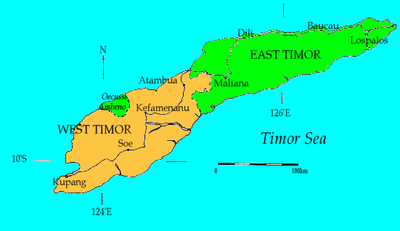Great Timor

The unification (or re-unification) of East Timor, an independent state, and West Timor, a territory of Indonesia, both parts of the island of Timor, that share language and ethnicity, has been raised since the mid-20th century. Great Timor (Indonesian: Timor Raya) refers to the irredentist concept of a united and independent island of Timor, covering formerly Portuguese East Timor and formerly Dutch (now Indonesian) West Timor.
Historically, the idea of uniting Timor Island had been expressed by several Timorese groups. The earliest reference point is the pre-colonial Empire of Wehali, whose center was in today's West Timor, but the ruling group was the Tetun speaking Belunese associated with the inhabitants of the Eastern Timor.[1]
During the Japanese Occupation of the Island (1942–45), there were some Japanese and Timorese efforts to unite West and East Timor through match-making between the traditional authorities of Dutch and Portuguese Timor. Especially, Tōru Maeda (a Japanese intelligence agent, later poet, who served in Viqueque and Atambua) was instrumental in a matchmaking between the family of Don. Joaquim da Costa of Ossu and the Nai-Buti clan in Atambua.[2]
During 1974–75, APODETI, an East Timorese party expressed its will to integrate East Timor and West Timor through an integration into the Republic of Indonesia. This idea was reflected in the original Portuguese version of so-called Balibo Declaration in which the signatories lamented the separation with the "Indonesian people of Timor" through demarcation of the colonial borders.[3]
East Timor was invaded and occupied by Indonesia in 1975, which annexed the territory as its "27th Province" in 1976, but in a referendum held in 1999, the people of East Timor voted to end Indonesian occupation and become an independent state. This caused widespread anger among many Indonesian nationalists, particularly in the military.
In 2001 and 2002, before East Timor's independence, there were claims by the Indonesian military [4] and some commentators,[5] that this would inspire the secession of West Timor from Indonesia.
FRETILIN's independence movement never laid claim to West Timor at any time, before the Indonesian invasion or thereafter. After the Recovery of Independence in 2001, the government of East Timor fully recognises Indonesia's existing boundaries as inherited from the Netherlands East Indies.
References
- ↑ Therik, Tom (2004). Wehali : the female land : traditions of a Timorese ritual centre. Canberra: Pandanus Books, in association with the Dept. of Anthropology, Research School of Pacific and Asian Studies.
- ↑ Maeda, Tooru (1982). Chimoru-Ki. Japan: Soudosha. pp. 125–163.
- ↑ BookMarc (PDF) http://xdata.bookmarc.pt/cidac/tl/PP0846-3.pdf. Retrieved August 24, 2016. Missing or empty
|title=(help) - ↑ etan.org
- ↑ The Jakarta Post Archived 2006-02-18 at the Wayback Machine. "There are even rumors of a Timor Raya (Great Timor) and while the Indonesian authorities have denied the existence of such a movement to unite East and West Timor, it should not ignore the possibility of such an idea. Again, it is Australia that would benefit greatly from a Timor Raya."
External links
- The Jakarta Post: February 26, 2005 (ETAN selected articles)